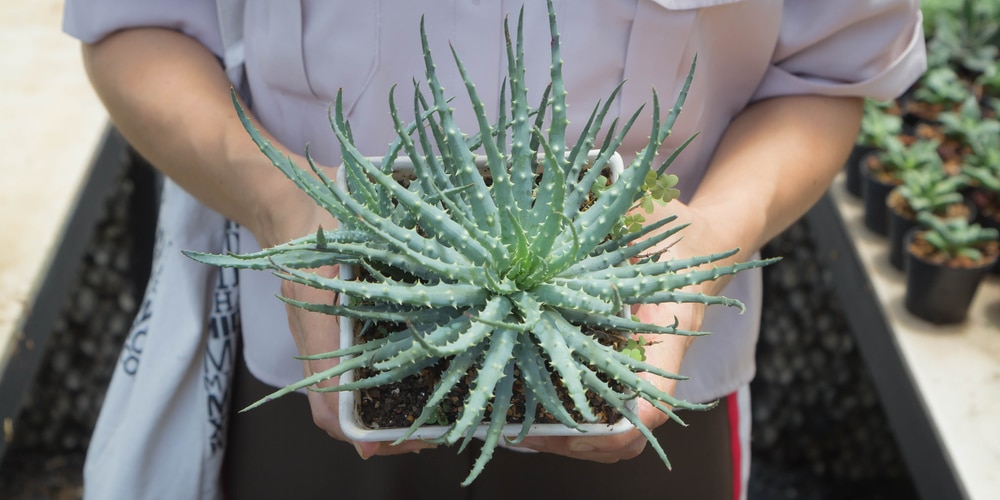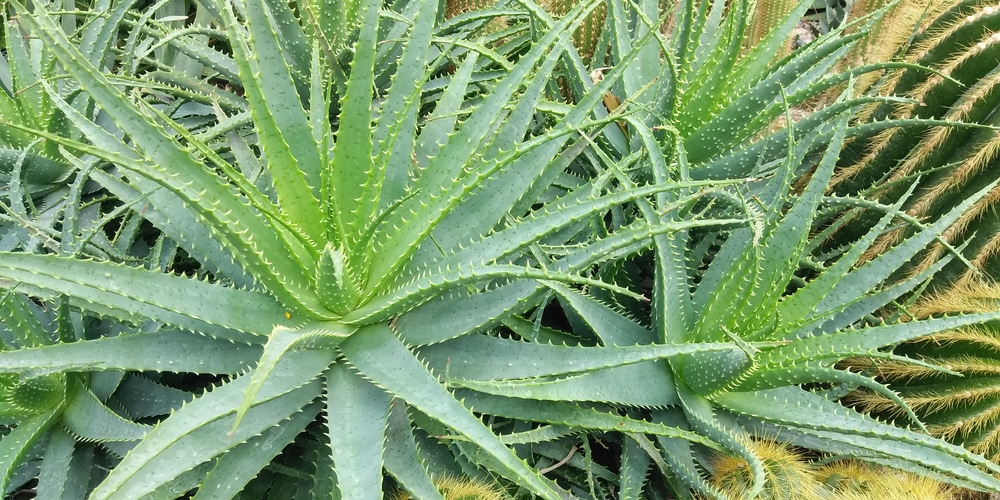If you like succulents, you will for sure fall in love with Hedgehog Aloe (scientific name: Aloe Humilis). This perennial, native to the Eastern and Western capes of South Africa, is the ideal indoor plant if you are looking for something that requires little maintenance and will survive even without much water. Of course, you’ll still have to give your plant some care. In our essential guide, you’ll find everything you need to know to grow a thriving Hedgehog Aloe at home.
What you Need to Know About Hedgehog Aloe

Also known as Spider Aloe, this compact plant is a slow grower that won’t reach heights taller than 16 inches. Its thick green leaves display white teeth on their edges and grow in clusters of rosettes. When growing outdoors, this type of aloe produces large blooms that appear during the spring and summer. With enough direct sun, you will be able to enjoy red, yellow, or orange flowers. During the blooming period, your aloe will attract beneficial pollinators and contribute to making your garden a lively place.
The best part about Hedgehog aloe is that as long as you provide it with bright light and relatively warm temperatures, you don’t have to do much more for your plant to thrive.
If you have pets, monitor your plant: it can be moderately toxic if ingested. Even humans can show symptoms of intoxication, so make sure your kids don’t munch on it.
How to Care for Hedgehog Aloe
As we mentioned, caring for this type of aloe isn’t complicated. However, if you want to have a healthy and thriving plant, you’ll have to make sure you meet its basic requirements. Jump to the following sections to learn what you can do to provide your plant with optimal growing conditions.
Light
This type of aloe is versatile when it comes to light. However, it prefers full sun, better if indirect. If you are growing it indoors, make sure you place your aloe next to a window. While this plant will survive in partial shade, insufficient light will cause its leaves to droop downwards and halt growth. Also, remember that a weaker plant will be more susceptible to diseases. To prevent that from happening, ensure your hedgehog aloe receives at least a couple of hours of sunlight each day.
Water and Soil Needs
Succulents are a lazy person’s favorite plant for a reason. You won’t have to worry too much about the watering schedule. Be careful not to overwater the plant as it will suffer and struggle to survive. Allow the soil to dry before watering your plant. Water until it flows through the drainage holes of its pot. Don’t forget to throw away any excess to prevent rot root. If you are growing your aloe outdoors, you may have to water it more often, especially under direct sun.
Because of this plant’s sensitivity to wet soil, you must choose a well-draining potting mix. You can recreate optimal conditions by mixing perlite or vermiculite with organic matter to regular succulent soil. Doing so will ensure proper drainage and adequate nutrition.
Temperature Requirements
This plant will thrive indoors as it requires temperatures between 65 to 75�F to survive. Avoid exposing it to low temperatures. Also, this plant prefers dry environments, so there is no need to mist its leave or purchase a humidifier.
What USDA climate zone can it survive?
This plant thrives in hot and dry conditions. You can plant it outdoors in USDA hardiness zones between 8 and 11. However, make sure you check on it and remove any weak growth to reduce the likelihood of attacks from pests and diseases. Also, move your plant indoors if temperatures drop below 60F.
Fertilizer
You don’t have to add fertilizer to your aloe. This slow-growing plant takes its energy from sunlight. Plus, if you add organic matter to the potting mix, your aloe will have more than enough nutrition for thriving. Consider replacing the potting soil once every couple of years for best results. However, if you like to give it extra care, feed it once a month throughout the spring and summer with a fertilizer specific to succulents.
Common Diseases
Indoors, this plant can suffer attacks from scale and spider mites. Make sure you plant your aloe in well-draining soil or use a pebble tray to improve drainage and limit the chances of attack. If you notice mites, use a cotton swab dipped in alcohol to wipe them off.
Outdoors, snails and slugs might munch on your aloe’s leaves. You can deter them by adding diatomaceous earth around the potting soil.
Common Problems
One of the most common problems with succulents is overwatering. Giving your aloe too much water is one of the fastest ways to kill it. If you notice some yellowing or browning around the leaves, you should lower the amount of water you give your plant.
On the other hand, droopy leaves are a symptom of a lack of sunlight. Move your plant somewhere brighter to reverse the condition. Try not to fall into the temptation of trimming individual leaves to remove browning: they won’t grow back and will leave you with a sad-looking aloe.
Hedgehog Aloe Propagation
If you fell in love with your aloe plant, you might want to propagate it. Also, you can consider gifting your new aloe plants to friends and family. After all, creating new plants from your existing hedgehog aloe is particularly easy. Only, you’ll have to wait until your plant is a couple of years old.
Aloe produces offsets (also called pups or offshoots) that grow from the central stem of the main plant. After getting some nutrients and water from their parents, pups develop individual roots. You can replant them to allow them to grow in proper space. All you have to do is divide the plant (with care not to disturb roots) and add some rooting hormone to the soil you decide to plant your aloe’s offspring. Another (less effective method) is leaf cutting. W recommend using offsets for better results. However, if a healthy leaf broke off your plant, you may want to try this method.
Hedgehog Aloe: The Bottom Line
So, now that you know how to create the best conditions for your hedgehog aloe to thrive, nothing is stopping you from getting one of these stunning plants!

